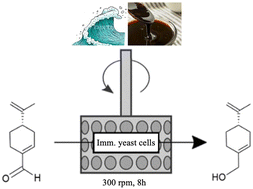Boosting the catalytic performance of a marine yeast in a SpinChem® reactor for the synthesis of perillyl alcohol†
Abstract
A sustainable approach for the reduction of perillaldehyde to perillyl alcohol (POH) through alginate immobilized yeast cell beads has been here developed. The process was optimized in small-scale batch reactions and then scaled up in a rotating bed reactor (SpinChem®), enhancing productivity while reducing catalyst loading thanks to better mass transfer and catalyst/substrate interaction (i.e., 90% molar conversion, 8 hours). The biocatalyst biomass was also grown on waste material (molasses) and cultivated using seawater to minimize the environmental impact. By harnessing the potential of immobilized yeast cells in a rotating reactor and utilizing eco-friendly resources, this study exemplifies a sustainable biocatalytic approach that can be extended to other natural terpenes. The incorporation of waste materials and seawater into the process showcases the commitment to increase the sustainability of chemical reactions and aligns with the principles of circular economy.

- This article is part of the themed collection: Emerging Investigator Series


 Please wait while we load your content...
Please wait while we load your content...